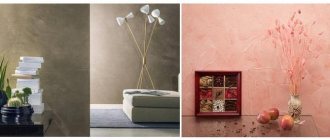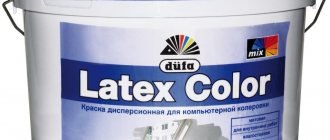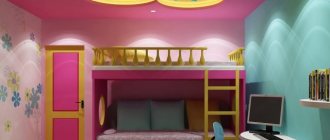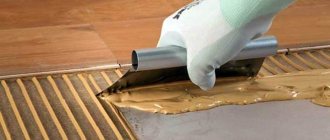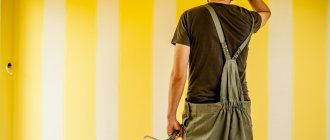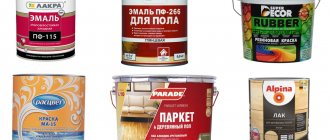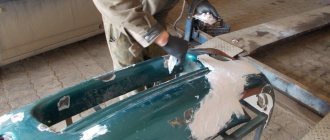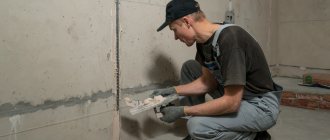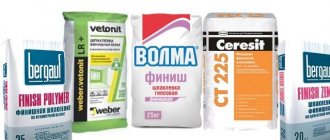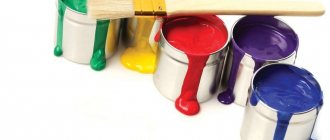Safe paint for children's rooms
Paint for walls in a children's room should first of all be safe for your baby's health.
Common household paints can contain up to 10,000 different chemicals, including hundreds of known toxins and carcinogens. And when the paint film dries, harmful volatile organic compounds (VOCs) are released into the air, polluting the environment. They are completely invisible to the eye and can be intangible.
VOCs are harmful chemicals that easily evaporate into the air at room temperature. These include chemicals such as gasoline, benzene and formaldehyde and solvents such as toluene and perchlorethylene (the main solvent used in dry cleaning). They react with sunlight and heat, creating smog that is invisible to the eye.
Although VOC emissions are highest during and immediately after painting, they can continue to emit low levels of toxic emissions for several years.
Quality paint for children's
Pay attention to the quality of paint for the children's room, look for products with low and acceptable levels of volatile chemicals (VOCs). VOCs are often responsible for allergies and upper respiratory tract diseases, not only in children but also in adults.
Children are much more susceptible to harmful substances than adults. This is due to greater absorption of their skin, that is, with easier penetration of active substances into the baby’s body.
To choose paints that are safe for use in children's rooms, pay attention to the presence of certificates indicated on the packaging confirming the correct composition of paint and varnish products: - EU Ecolabel, which is valid in 25 countries of the European Union.
Remember that the paint for a children's room should be hypoallergenic, resistant to damage and dirt, and easy to clean, without losing its original and beautiful appearance.
Flugger paint for children's rooms
The Flugger concern has many years of experience in the production of paints and varnishes (since 1783) and constantly strives to reduce the content of harmful chemicals in its products. This also includes the fairly strict legislation of Scandinavia and Denmark, including where it is constantly required to undergo all kinds of checks and mandatory certification of products and production itself.
Plus, Flugger purposefully undergoes certification, thereby showing the consumer that the products it produces are harmless to people and the environment. Such certificates that mark Flugger products include ECO Label and Nordic Swon.
The company has paints that are recommended for painting children's rooms. They are quite easy to maintain, endowed with increased wear-resistant characteristics and resistance to wet cleaning. Also, all these products are certified on the territory of the Russian Federation, have passed mandatory certification, are included in the state register and are recommended as: for interior decoration of premises, including children's schools and preschools, medical and treatment institutions of Class A, B.
Flugger Products
- Matte, wear-resistant, withstands local cleaning and wet cleaning. More details about the product itself - FLUGGER DEKSO 5
- Silky-matte, withstands local cleaning and wet cleaning (in light colors). About the product itself - FLUGGER FLUTEX 10
Painting walls is the fastest and most practical way to redecorate a room. A new paint color will refresh the look of a child's room and, if done correctly, will delight the child.
Painting a children's room: benefits and convenience
The children's room is a special place in the apartment. It should be not just a living room with a bed, but a place of development, games, new discoveries and impressions. To do this, it is important to provide for the functionality of the room and use the most obvious thing for the child’s development - the walls. It is enough to paint them with the necessary paint: slate, magnetic, marker. Or buy a board for creativity. Let's consider what is more profitable, convenient and interesting.
Paint for a children's room VS board
Everyone knows that children love to draw on walls, and prohibitions help little here. Therefore, “if you can’t prevent something, lead it,” namely, make the walls so that you can draw on them. For example, marker ones. To do this, use a special magnetic marker board or paint. In addition to the marker wall, you can make a wall on which the child will draw with crayons. To do this, buy a magnetic chalk board or use paints.
Pros and cons of the board
The advantage of the board is that you don’t have to bother with painting the walls. We bought a board, brought it home, mounted it on the wall and can use it. Magnetic chalkboards have different colors to choose from (school green, graphite, even pink).
Disadvantages - it’s difficult to explain to a child why you can only draw on this wall (and even more difficult to control). Slates are associated more with school and “obligation” than with freedom of creativity; limited size, odds Pros and cons of colors for a children's room
Pros and cons of paints for a children's room
The advantages of paint - you can paint over all the walls in the nursery (and even the floor, if the child likes to paint it too). For example, you could paint two walls with magnetic paint, then make one all marker and the other all chalkboard. You will get a magnetic marker wall where the child will draw with markers and a magnetic slate wall for crayons. And if it gets mixed up, use Sketch Cleaner board cleaning spray.
The downside is that you need to hire a painter (money) or paint it yourself (time). If you paint yourself, then choose marker coatings SketchPaint and SketchPaint Paint for Pros, slate BlackboardPaint, as well as magnetic MagPaint and MagnetPlaster - they do not contain VOCs, they are easy to use even for an untrained person. Just buy a short nap roller, paint tray, masking tape (and a putty knife and trowel if using stucco) and follow the application instructions. There will be no difficulties.
Which is more convenient? You need to spend less time on the board, but that’s where its advantages end. The board is not original, it is difficult to fit it into the room so that it remains a child’s room and not a branch of an office or school. You need to tinker with the paint (paint it, dry it), but it gives you complete freedom of creativity - you can make a magnetic marker and magnetic slate surface of any size and any shape (even in the shape of an elephant), not just white or black (just paint it transparent marker or slate paint on the wall in the desired color).
Which is more profitable?
1. Magnetic marker surface
The larger the surface, the more beneficial the paint for the children's room.
If you need a board smaller than 1.5 m², a magnetic marker board is cheaper. For example, a 100x150 cm board costs about 3,500 rubles - about the same price as magnetic and marker paints for 1.5 m².
Large boards are much more expensive, and large volumes of paint, on the contrary, are more profitable, so if you need more than 2-3 m², take paint. It will be cheaper even taking into account the painter or the cost of tools.
For example, a magnetic marker board 120x300 cm costs about 15,000 rubles, that is, 4,100 rubles per m². For about the same price you can buy magnetic paint MagPaint 1 liter and marker paint SketchPaint 1 liter (8000+7000=15000), which is enough for 6 m². The difference is twofold.
2. Magnetic slate surface
An ordinary school magnetic chalk board 100x170 costs about 4,000 rubles. Magnetic and slate paints for 2 m² - 3,400 rubles (or about 4,000, if we consider that the minimum can of slate paint costs 1,100 rubles, but it is enough for 5 m²). That is, in this case it is more profitable to buy paints, even if you want to make a small magnetic slate board.
Interior colorful selection
1. Magnetic paint VS magnetic plaster
Magnetic paint MagPaint is applied in 3 layers, and MagnetPlaster plaster is applied in one layer. If you hire a painter, it is more economical to use plaster (pay in one go). If you paint it yourself, plaster saves time - each layer of paint dries for 4 hours, the final one - 24 hours; The plaster layer dries for 24 hours.
But paint also has its advantages - it is cheaper than plaster. If you take the minimum volume of paint (0.5 liters per 1 m²), the consumption is 1,750 rubles/m² . A minimum can of plaster (2 liters per 2 m²) costs 2,300 rubles/m² . The largest volume of paint (5 liters) costs 1,450 rubles/m² . Plaster (5 liters) - 1840 rub./m² .
2. Marker paints SketchPaint and SketchPaint Paint for Pros
Both paints are applied in one layer (you only need to call a painter once) and are odorless and VOC-free.
Pros SketchPaint Paint for Pros is the only one-component paint (no need to mix components, leftover paint can be stored), dries in 24 hours.
The advantages of SketchPaint are that it has white and transparent (SketchPaint Paint for Pros only has transparent), matte and glossy finishes (SketchPaint Paint for Pros only has glossy).
Less expensive than SketchPaint. If we take the minimum volumes, SketchPaint (0.5 l per 3 m²) comes out to 1420 rub./m² , SketchPaint Paint for Pros (250 mg jar per 3 m²) - 1830 rub./m² . The largest containers: SketchPaint (1 liter) - 1330 rub./m² , SketchPaint Paint for Pros (1 liter) - 1420 rub./m² .
Surface Maintenance
Naturally, a painted wall is easier to update than a special board, so paint wins in terms of durability and possible cosmetic repairs.
Colors for a children's room
How to choose a color for a children's room?
When choosing a paint color for a child's room, it is important to consider the size and shape of the room, furnishings, and floor finish. Don't forget about your child's wishes and opinions - what colors does he like?
The color doesn't have to be overwhelming, consider whether it will match and coordinate with the furniture in the room. Children's toys and accessories will add additional color, and the room will become colorful even if you choose white as the main color.
It is better to choose no more than 2-3 shades. For example: a calmer tone as the base and one stronger color that will become an accent. Using this technique, you can give the room individuality, highlight separate areas in the room for various types of children’s activities: a place to sleep, play, study, etc. This will help the children become more collected and accustomed to order.
A popular technique has become the use of slate black paint - you get an accent area (wall), a place for entertaining and painting.
How to choose colors for a nursery
It is better to choose colors directly in the nursery room that will be painted. If you plan to use several bright, saturated, perhaps contrasting shades, it is better to spend a little time and look at them in different lighting. You will see how different the same color can be in: daylight, evening, and artificial light.
When choosing a color for a nursery, the amount of sunlight plays a big role. Lack of light and being in a dark, cold room can cause drowsiness, fatigue and discomfort.
If the children's windows face the north or west, where there is little light, you should give preference to light, warm shades and add bright colors. Conversely, a room with windows located to the south or east requires the use of cooler tones. An interesting solution is to combine the colors of warm and cold delicate shades, for example yellowish and light gray.
How color affects our emotions
Color helps to calm down or, on the contrary, awakens the desire to act and improves mood. Color is a simple stimulus that affects the brain through the eyes, causing various reactions - it affects the way you feel, think, and behave.
Painting: relevance
Decorating a children's room is possible by covering the walls with wallpaper, laying them with artificial stone, or plastic panels. But the current proposal is to paint the walls.
This solution is original and practical, because sooner or later in a baby’s life there comes a period of drawing on smooth surfaces. Cleaning painted walls is very easy, especially if they have a glossy structure, and therefore the advantages of using wall paint are obvious:
- the paint is not afraid of moisture;
- has high color fastness;
- does not create a greenhouse effect;
- does not require selection of pattern and texture;
- lasts longer;
- allows you to realize any design ideas.
Paint selection criteria
The choice of paint in a children's room is approached responsibly.
Safety is the main criterion for selecting wall coverings. Paints containing synthetic solvents are definitely not suitable. Therefore, the choice falls exclusively on safe-based paints; water-based, acrylic, latex and silicone compositions are suitable. They do not release chemical components into the air, dry in 10-20 minutes, lay down evenly, and have a protective film upon drying. Even pregnant women can use some paints without harm to their health.
The resistance class of water-based paints is from 1 to 5, which means that the coating guarantees increased wear resistance. To decorate the walls in the nursery, paints that have a certification inscription on the can for use in children's and medical-prophylactic premises are suitable. These include:
- latex paints - have high strength, are durable and dry quickly;
- acrylic - inexpensive paints, have a dense matte structure;
- silicone paints are a new generation, have an attractive smooth surface, repel dirt, and are washable.
The process of painting children's furniture
To eliminate all the negative aspects that arise during the painting process and affect the health of your baby, you need to carefully familiarize yourself with all stages of painting and learn all the features of paint and varnish products used for children's furniture.
Main characteristics of paint and varnish products for children's furniture:
- Absence of harmful substances in the composition of paints and varnishes. If such substances are present, they can evaporate into the atmosphere, thereby causing an allergic reaction, leading to irritation of the mucous membranes, or causing any other reaction in your baby to these substances included in the paintwork materials.
- The absence of toxic chemical compounds, heavy metal salts, toxic oxides and harmful organics in the composition of paints and varnishes. Since the child often puts everything in his mouth, the paint can get into the child’s internal organs and cause an irritating or poisonous effect.
- Only safe solvents, or better yet water, should be used to make paint that you are going to paint children's furniture. After all, even after the painted surface has dried, the solvent impurities used in the production of paints and varnishes remain on it.
- It is necessary to opt for non-flammable coatings or coatings that will not release toxic substances when burned.
- The layers of paint with which you paint the surface of the furniture must be highly durable, easy to clean, flexible and wear-resistant. Since furniture in the nursery is subject to damage every day, it must be constantly washed, wiped, and mechanical pressure is applied to it during games.
- The paint should have bright and colorful colors with a large selection of colors; you also need the possibility of tinting so that you can bring to life not only your fantasies, but also the desires of the child.
What colors are suitable for a children's room?
The most suitable are water-based paints for a children's room; they, in turn, are divided into:
- Acrylic paint based on acrylic resins forms a durable film that perfectly protects the surface from scratches and cracks.
- Rubber-based latex paint is quite elastic and resistant to mechanical stress.
- Silicate paints with mineral components have an antibacterial effect.
- Silicone-acrylic compositions, in addition to acrylic, also contain silicone; such surfaces can be easily washed and are resistant to mechanical stress.
- Acrylic-latex - very strong and durable.
